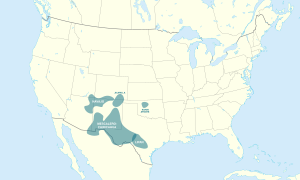Southern Athabaskan languages facts for kids
Quick facts for kids Southern Athabascan |
|
|---|---|
| Apachean | |
| Geographic distribution: |
Southwestern United States |
| Linguistic classification: | Dené–Yeniseian?
|
| Subdivisions: |
Western Apachean
Eastern Apachean
|
| ISO 639-2 and 639-5: | apa |
 Historical distribution of Southern Athabaskan languages
|
|
Southern Athabaskan (also called Apachean) is a group of Athabaskan languages. These languages are mostly spoken in the Southwestern United States. This includes states like Arizona, New Mexico, Colorado, and Utah. You can also find speakers in Oklahoma and Texas. Some people in northern Mexico, in states like Sonora and Chihuahua, also speak these languages.
Different groups of Apache and Navajo people speak these languages. Other Athabaskan languages are spoken by many native groups in Alaska, Canada, Oregon, and northern California.
For example, Western Apache speakers call their language Nnee biyáti’ or Ndee biyáti’. Navajo speakers call theirs Diné bizaad or Naabeehó bizaad.
Many famous historical figures spoke Southern Athabaskan languages. Geronimo, a well-known Apache leader, spoke Chiricahua. Manuelito, a Navajo leader, spoke Navajo. He was famous for leading his people during and after the Long Walk of the Navajo.
Contents
Understanding the Language Family
There are seven main Southern Athabaskan languages. A linguist named Harry Hoijer grouped them into two main parts: Plains and Southwestern.
- Plains Apache is a language spoken by the Naishan people.
- The Southwestern group is larger. It includes two subgroups:
* Western languages: These are Western Apache, Navajo, Mescalero, and Chiricahua. * Eastern languages: These are Jicarilla and Lipan.
Mescalero and Chiricahua are very similar. People who speak one can often understand the other. Western Apache and Navajo are also quite close to each other.
Sadly, some of these languages are in danger of disappearing. Lipan Apache and Plains Apache are almost gone. Chiricahua, Mescalero, Jicarilla, and Western Apache are also endangered. This means fewer children are learning them.
However, Navajo is one of the strongest Native American languages. Even so, the number of young children learning Navajo has gone down in recent years.
Sounds of the Languages (Phonology)
The sounds in Southern Athabaskan languages are quite similar. Let's look at how sounds work, especially in Western Apache. Other related languages like Navajo and Jicarilla have similar sound systems.
How Sounds are Made (Consonants)
These languages have many consonant sounds. Some sounds are made by stopping air completely, like 'p' or 't'. Others are made by letting air flow, like 's' or 'h'. Some sounds are "glottalized," meaning they are made with a quick stop in the throat, like a tiny cough.
The way these languages are written usually matches how they sound. For example, the sound 't' is often written as 'd'. The sound 'k' is often written as 'g'. This is different from English, where letters can make many different sounds!
Vowel Sounds
Southern Athabaskan languages have four main vowel sounds: 'i', 'e', 'o', and 'a'. These vowels can be short or long. They can also be "oral" (air comes out of the mouth) or "nasal" (air comes out of the nose, like when you say "hmm").
For example, in Chiricahua Apache, the word cha̧a̧ means 'feces' (with a nasal 'a' sound), but chaa means 'beaver' (with a regular 'a' sound). This shows how important it is to get the sounds right!
Language Tones
These languages are also "tonal." This means the meaning of a word can change depending on the pitch of your voice when you say it. Imagine saying "hello" with a high pitch versus a low pitch – it can change the feeling! In these languages, it changes the word's meaning.
There are usually four tones:
- High tone: Like saying a word with a high pitch. It's often marked with an accent mark like á.
- Low tone: Like saying a word with a low pitch. It's often not marked, like a.
- Rising tone: The pitch goes up.
- Falling tone: The pitch goes down.
For example, in Chiricahua:
- shiban means 'my buckskin' (low tone).
- shibán means 'my bread' (high tone).
This shows how a small change in tone can completely change what you are saying!
Grammar
To learn more about how sentences are put together in these languages, you can visit the main article: Southern Athabascan grammar.
nv:Wikipedia in Navajo
See also
 In Spanish: Lenguas apacheanas para niños
In Spanish: Lenguas apacheanas para niños

